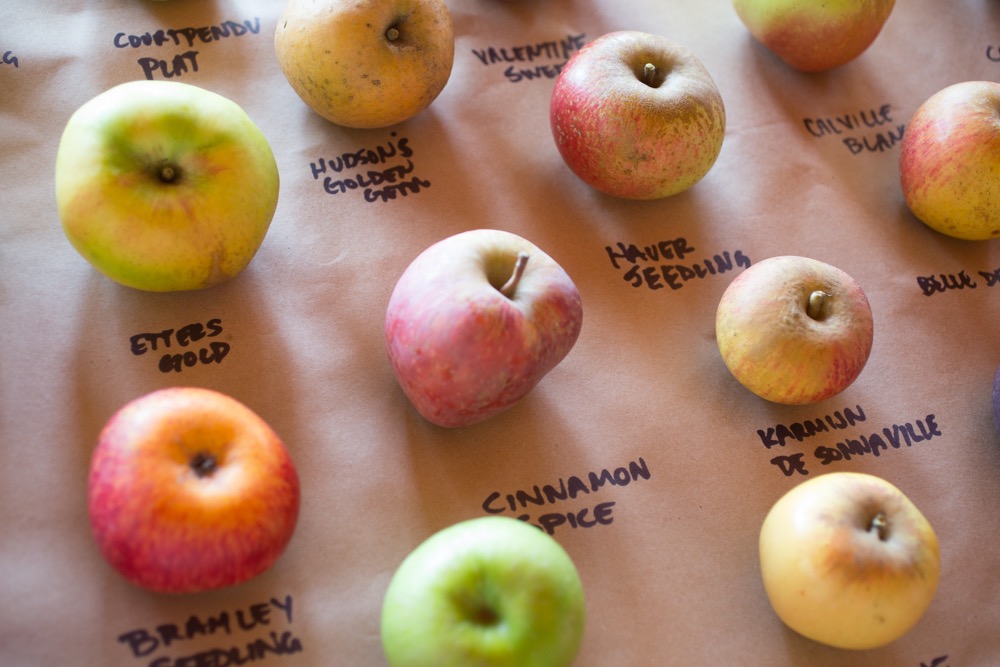Ruby Red. Humboldt, CA. 1940s. Ruby red fruit, both inside and out. Intense aromatic flavor, tart early in the season, later becoming sweet-tart.
Firm, juicy flesh cooks-up to a rich cranberry flavor and color. Bred by Albert Etter of Pink Pearl fame.
King David. Arkansas, 1893. The dark red, nearly maroon skin of this classic southern apple hides highly aromatic, spicy flesh with plenty of sprightly acidity. The tree was discovered growing in a hedgerow in Washington County, Arkansas and is believed to be a seedling of the Jonathon. It certainly has the juicy sweetness of its parent, which lends itself well to cider. Cooked, the King David has a rich yellow color and vibrant flavor. King David is memorable for dessert, pie and sauce making.
Belle de Boskoop. Netherlands, 1856 A big apple, in all ways. Throughout northern Europe, Boskoop is considered one of the major baking apples. Its firm juicy, sharp flesh holds its shape when cooked, and boasts a powerful, brisk apple flavor. Too acidic for most people to to enjoy eating out of hand; great for all culinary uses.
Suntan. England 1956. Cox’s Orange Pippin (the highly esteemed British dessert apple) crossed with Court Pendu Plat (the apple of the Romans), this apple is packed with flavor. It impresses one with its distinctly rich, pineapple-like acidity. This may be my favorite eating apple. Cooks up to a brisk, strong flavor, but softer texture than a Spitzenberg. Suntan has a beautiful antique appearance, but the flavor is too brazen and polarizing for commerce.
Spitzenberg. New York 1700s. This sweet-sharp, complexly flavored apple is said to have been Thomas Jefferson’s favorite apple based on the large number of this variety planted at Monticello (36!). Unexcelled in quality, this large bright red apple has yellow tinged flesh, and is firm, aromatic, and complex in flavor; a perfect balance of lively acidity and sweetness’. A.J. Downing, America’s foremost nineteenth-century pomologist, described ‘Esopus Spitzenburg’ as “a handsome, truly delicious apple…unsurpassed as a dessert fruit…considered the first of apples.” Today, apple connoisseurs still consider this variety among the finest ever known. Besides being great out of hand, it’s the apple around which the Waldorf salad was devised, and boasts enough acid to bake up rich, flavorful and intact, making it a first choice for pies and tarts.
Golden Russet. New York state, 1845. Probably a seedling of a russeted British variety, Easy to grow in Santa Cruz county. Musky, sweet, flavorful, this apple has a singular appeal when eaten out of hand, and ferments into a delicious hard cider as a stand alone variety.
Stardust. Aromas, CA, 2008. Chance seedling found in an abandoned orchard. Fine high flavor, crisp breaking texture that holds well in storage. This apple appears to be a cross of Yellow Bellflower and McIntosh, combining the best traits of both, while avoiding the major shortcomings of each.
Karmijn de Sonnaville. Netherlands, 1949. A cross of Cox’s Orange Pippin and belle de Boskoop, the flesh is juicy, aromatic, hard, and yellowish, with both high sugars and good acidity. Warren Manhart, author of modern apple bible, “Apples of the 21st Century” is dependably quite frugal in his praise when he writes about this apple: “When one bites into a Karmijn, there is such a reaction, it is difficult to keep from coming out of your chair. Perhaps this is not for those who like mild sweetish types of apples. After observing many taste tests at…fruit shows, there is no doubt this is one of the best liked of the high-flavored apples.” The bold flavor stands out either fresh or cooked.
Wickson Crab. Humbolt, CA 1940’s. Another of Albert Etter’s northern California crosses; this small apple is loaded with flavor. Said to contain both very high sugar and acid, the Wickson is famous for producing a clear, lively, apple Champaign. It has enough flavor roasted, pickled or baked whole, to offer zesty contrast to meats and savory dishes. Wickson has an excellent, addictive, sweet tart flavor with a crisp, juicy texture.
Brushy Mountain Limbertwig. Brushy Mountain North Carolina, 1800s. One of a group of antique American apples known as ‘Limbertwigs,’ whose trees exhibit a weeping form, this apple hails from the area of the famous Brushy Mountain penitentiary. Easy to grow in S.C. County, it has been described as “sweet and crisp like a Fuji, but with flavor.”
Pineapple Candy. Watsonville, CA 2010. A cross between Wickson Crab and Court Pendu Plat, this apple was bred by Freddy Menge. Sweet and spicy, and small like its crab apple parent.
Hudson’s Golden Gem. Tangent, Oregon, 1931. Another chance seedling, this one found growing in a hedgerow thicket. With its elongated shape and russeted skin, it could easily be confused for a pear. This is a richly sweet apple, but it’s anything but bland, boasting an unusual vanilla/pear flavor, and has been a favorite at our apple tasting, of the humans and yellow jackets alike.
Heirloom Apple Tasting Box
$25

Each box includes a key, with background notes on each of the apples.
We feature only unusual, hard-to-find-elsewhere apples at their peak of ripeness. We put together what we feel to be the most interesting apples maturing each week. Choice heirlooms, new selections from local breeding projects, exceptional foundlings rescued from abandoned orchards around the county make up the menu.
Varieties change weekly as apple season progresses, no two weeks’ boxes will ever be the same.
We make a few boxes for the farmers market every Saturday, but to avoid disappointment, we strongly recommend you order ahead, by Thursday night, to reserve one.
Makes a great gift for the foodie in your life!
